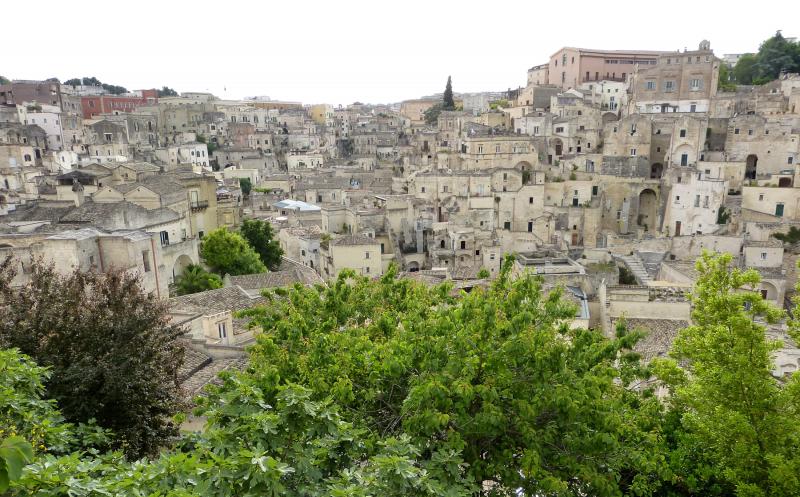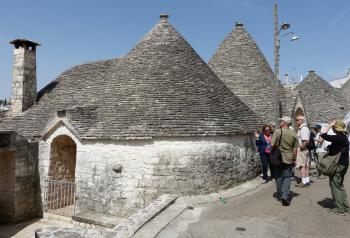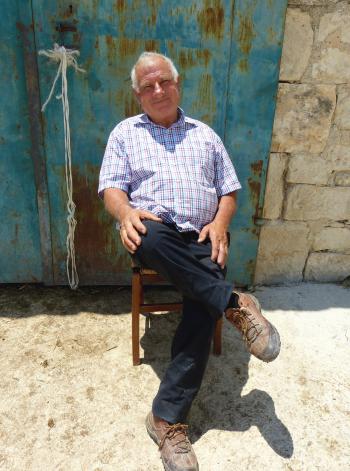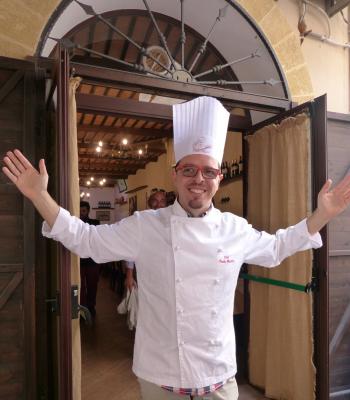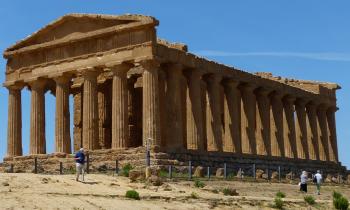Admiring the ancient landscapes of Sicily and Puglia
This article appears on page 18 of the October 2016 issue.
When I think of Puglia, my mind’s eye sees swooping swallows, stands of ancient olive trees and fields carpeted with red poppies. I hear church bells chiming, announcing not just the hours but the quarter hours as well.
When my mind wanders back to my May-June 2016 Italian adventure — the 15-day “Sicily’s Ancient Landscapes & Timeless Traditions” tour from Overseas Adventure Travel and their 5-day pre-trip tour of Puglia* — I find myself returning to the city of Matera on day one.
I see myself seated on the terrace of my hotel room overlooking Matera’s sassi (cave dwellings). Above, around and tumbling into a ravine, cave dwellings were piled atop cave dwellings, laced together in a maze of stone steps and cobbled lanes.
People have lived in these limestone-hewn accommodations for centuries; one revealed tools and bones from 10,000 years ago. Man came early to Matera and still remains.
A little history
Romans en route to Roman colonies founded the city in 251 BC. In the sixth century, Basilian monks fleeing persecution carved churches and monasteries into the stone, brushing frescoes on the walls. Benedictine monks and nuns arrived later, carving out still more churches and adorning them with Madonnas, angels and saints.
The Normans arrived in 1042 and made Matera magnificent, adding elegant palazzos and grand piazzas.
More modern times were not good to the sassi, with the early 19th century marking their slide into decline. The aftermath of World War II found a population malaria-ridden and virtually starving — out of sight and forgotten by the new republic’s central government in Rome.
In the 1950s, the remaining 16,000 inhabitants were relocated from what was known as “the shame of Italy,” leaving behind one of the greatest abandoned historical centers of the world.
In recent years, life has returned to the sassi. Artists and craftspeople moved in, and restaurants, shops and hotels opened. The 32-room hotel in which our group was staying, the luxuriously renovated Locanda di San Martino, in times past comprised a like number of dwellings.
As if arising from the dead, “the shame of Italy” was named a UNESCO World Heritage Site in 1993 and, for 2019, a European Capital of Culture.
Exploring Matera
After all 10 pre-tour participants had arrived, we assembled to meet each other and our Overseas Adventure Travel (OAT) tour leader, Flo Iacobozzi, who would see us through Italy’s spur-of-the-heel (Puglia) and instep-of-the-boot (Matera is actually in the neighboring region of Basilicata) prelude to Sicily.
Flo told us of her deep Puglian roots and then asked each of us to tell a bit about ourselves, including any previous trips taken with OAT. All, with the exception of myself, at trip number one, were multiple repeaters, with one couple logging this trip as number 29.
The following morning, Flo introduced us to our local guide, who, with tales to tell and details at hand that only a resident would know — as was true of all the local guides we were to meet during our Italy stay — led us through the sassi’s labyrinth of alleyways and into its most notable structures.
Most memorable to me was Chiesa di Santa Lucia. Carved out in the eighth century as a Benedictine convent, its most recent use was as a dwelling, the nave closest to the entry turned into a kitchen. Glorious frescoes, faded and chipped by the centuries, remained on the walls, including one of the Madonna breastfeeding the infant Jesus.
That evening, along with several of my new traveling companions, I made my way up stone stairs to Piazza Vittorio Veneto. Lined with noble buildings constructed during Matera’s golden age, the piazza is central to the evening passeggiata. Elderly couples walked hand in hand, parents pushed strollers, and teenage boys and girls checked each other out. So it has been in the piazza for countless decades.
Wonderful in white
Our destination the following day was Matera’s polar opposite, the Baroque city of Lecce. En route, Flo took the mic to tell us about Puglia’s olive trees, of which, she said, there is one for every Italian… some 60 million. Many olive trees mark their years in the hundreds, making them so precious that they are governmentally protected.
Later that day we visited an olive farm. In its fifth generation of ownership, pressing is done in the traditional way. “The only thing missing is the donkey,” we were told.
With Flo leading the way, we paid a visit to Alberobello, known for its dazzling whitewashed display of conical-roofed, limestone-block trulli, iconic to this part of Puglia.
They were originally constructed as one-room shelters for animals or as peasant dwellings. In the older, quieter part of town, the oldest of the trulli date to the 14th century.
A second section of the town, jam-packed with tourists on that day, featured multiple opportunities to step inside a trullo for a gift-shop experience.
With dazzling white emerging as the theme for the day, we approached Ostuni, La Città Bianca, its array of white buildings flung on a hillside overlooking the Adriatic. A staircase climb took us to our lunch stop for the day, Ristorante Spessite.
Located in what was once an old mill, every inch of wall leading up to the room’s vaulted ceiling was covered with Puglian antiquity, ranging from farm implements to kitchen tools. When Flo asked the chef/owner about his eclectic display, he said with a shrug, “I like anything old.”
After lunch, winding streets took us into Ostuni’s historic center, its central piazza a showcase of Baroque and Renaissance splendor, all in dazzling white.
Lecce
Arriving in Lecce, we were greeted with over-the-top Baroque architecture. Our hotel, Patria Palace, was ideally located in the heart of the city, in the Piazza del Duomo, and Lecce Cathedral’s ornately sculpted façade was straight ahead. It was the first stop by our local guide on our morning walk-around tour of the city’s historical center.
While undeniably fanciful, the cathedral didn’t hold a candle to Basilica di Santa Croce’s exuberant exterior. Completed in 1695 after diligent work by three generations of artisans, it is adorned by hundreds of sculpted forms. We spotted pacing lions; undersea creatures; cross-bearing angels; dragons; flowers; birds; shells, and Turks in turbans.
A stop to view the second-century Roman amphitheater, discovered by workmen digging the foundation for a new building in the early 1900s, was perfectly timed to catch the Piazza Sant’Oronzo’s bell tower announcing the hour. At noon each day, instead of the clang of traditional bells, an aria floats out over the city, the voice of famed tenor Tito Schipa, born in Lecce in 1889.
Lecce takes its afternoon siesta seriously, with the city nearly closing down between 2 and 5. Flo, however, had arranged for us to visit another accidental archaeological discovery. When Lucciano Faggiano purchased a building on a quiet downtown street in 2000, all he had in mind was to open a trattoria. Then a sewage problem developed.
Digging about, he came upon more than the problematic pipe. Enlisting his young sons to pitch in, the family gradually unearthed 2,500 years of Italian history.
Faggiano’s would-be trattoria is now Museo Faggiano, an authorized independent archaeological museum. Relics continue to turn up today.
Our final day in Puglia offered an optional tour to Otranto ($120 per person), with all opting to go.
Otranto claims a curve of golden sand and turquoise sea on the Salento Peninsula. However, the beach could wait, as Flo took us directly to the 11th-century cathedral, a masterpiece of Gothic spectacle and madcap artistry.
In 1480, the mass beheading of 800 martyrs by the Turks took place there, and their skulls remain on grisly display. As for the artistry, the cathedral’s entire floor is a Tree of Life mosaic, its trunk and branches depicting scenes from every myth and legend known to the world circa AD 1100. Adam and Eve share floor space with Alexander the Great, elephants, unicorns, Norse gods, horned devils, griffins, minotaurs and winged angels.
Sicily
An early-morning flight delivered us to Palermo, where we met our Sicily tour guide, Alessio Graffeo, and the five additional travelers who were just arriving.
Of our group of 15, seven were traveling alone, five women and two men enjoying OAT’s no-single-supplement policy.
Over dinner in the rooftop restaurant of Hotel Porta Felice, where we would stay for three nights, Alessio filled us in on the itinerary to come.
A full day would be spent in exploration of Palermo, followed by an optional tour to two northerly coastal towns. Mazara would be our headquarters for the next three nights as we explored the city and surrounding area.
After a one-night stay at an agriturismo, a traditional farm sanctioned for lodging by the Italian government, the following three nights would be in the city of Ragusa, our tour with a local guide taking us through its two sections that cling to the hillsides of a steep ravine.
The final three nights of our Sicilian adventure would be headquartered in Catania.
Our hotels in Sicily were located in historical centers, making independent exploration easy during the afternoon free time usually allotted each day. Alessio provided an insider’s list of things to see and do.
Fabulous food
“I like to cook and I like to eat,” he told us. With that, we quickly got the idea that our days with Alessio would be as much a culinary journey as one of cultural discovery.
Positioned smack-dab in the middle of the Mediterranean, Sicily was vulnerable to attack and pillage for centuries. Some came to colonize and stay, resulting in a cuisine influenced by the ancient Greeks, Arabs, Normans, Spanish, North Africans and the cultures of the Middle East.
Whatever the derivation, dishes remain wedded to simple ingredients born of the fields, forest and sea. Sicilian’s proudly call it cucina povera, peasant food.
Our meal that first night in Palermo ended with the iconic Sicilian pastry cannoli, crispy rolled shells filled with whipped and sweetened ricotta, the ends dipped in chopped pistachios. Cucina povera? May I have seconds?
While in Palermo, we were invited to dinner at the home of Alessio’s in-laws for a feast of antipasti and pastas served in the courtyard of their house. We paid a visit to the Ballarò Market’s alleyways, jam-packed with prepared-food and fresh-produce stalls. There, Alessio encouraged the more adventuresome among us to sample offal every which way. (I decided I should try something, so I chose the grilled intestine hot off the fire. If I didn’t think about what I was eating, it was really quite good.)
Our optional tour day took us to the medieval town of Castelbuono in the Madonie Mountains, where we stopped to taste panettone and marzipan, for which the town is noted, as we made our way toward its 14th-century castle.
En route to Mazara the next day, we traveled to Segesta and a lunch at Agriturismo Tenute Pispisa that began with grilled onions and eggplant plus artichoke stems fried in breadcrumbs and slivers of marinated red peppers with capers. The meal ended with cherries plucked fresh from the farm’s trees.
A blessedly downhill 2-mile walk to meet our bus took us past Pispisa’s vineyards, the columns of a classic Greek temple overlooking our progress from a nearby hill.
In Mazara, jovial chef Paolo Austero greeted us at Osteria Scopari, an osteria (traditionally, a simple, rustic restaurant) and cooking school, where we donned white aprons and prepared our own 3-course dinner.
Our touring day ended with a visit to the Valley of the Temples’ stunning archaeological remains, featuring eight Greek temples located outside Agrigento. Then we continued on to our overnight at an agriturismo in Piazza Armerina. There, in an elegant setting of crisp linens and candlelight, dinner began with arugula-topped carpaccio, boar pâté with citrus marmalade and baby spears of asparagus wrapped in ham.
Our culinary adventures continued with a chocolate tasting following a wild ride through the impossibly narrow and hilly streets of Modica in a fleet of vintage Fiats; being treated by Alessio to what he claimed was Sicily’s best granita following our visit to the fourth-century-BC Greek amphitheater in Taormina, a vibrant little city perched on the edge of the Ionian Sea; the stirring of an enormous pot set over an open fire that would result in creamy sheep’s-milk ricotta during our day spent with a family on their generational dairy farm; wiping the last bit of risotto with mushrooms from our plates at Ristorante U Dammusu in the hilltop town of Chiaramonte Gulfi after a guided tour through Villa Romana del Casale’s extravagant Roman villa ruins, and picnicking on salads and fresh vegetable pastas while seated at a table and benches constructed of ancient hand-hewn stones on the small island of Mothya, settled by the Phoenicians some 2,700 years ago.
Another perspective
Along the way, touchy subjects were not ignored, notably the Mafia and immigration. In Palermo, Alessio introduced us to two men, each of whom grew up in a family headed by a Mafia-boss father. They spoke of what it was like to live in the heart of the Mafia and how that relationship continues to impact their lives to this very day.
In Mazara, where it is said that on a clear day one can see Africa, we met with Masrati Mustapha, who arrived from Tunisia in 1974 in hopes of finding a job, any job. Today he works as an intermediary between incoming Tunisians and the city’s population.
Mazara, we learned, receives one of the greatest percentages of Italy’s immigrants, most from Tunisia.
Masrati took us on a walk through the Casbah, the old Arab city center, where Jews, Christians and Muslims have long lived in harmony. Incoming Tunisians gravitate toward this section of the city.
As we traveled from city to city, cathedral visits began to blur, with one unforgettable exception: the 12th-century Monreale Cathedral in the hills above Palermo. Richly colored mosaics of glass tesserae against a gold background cover every inch of the interior. On one wall, one can “read” the Bible, from creation onward, with breathtaking clarity and expressiveness.
Among the museums visited, Catania’s Allied Landings in Sicily Museum remains unforgettable. In the midst of other extraordinary exhibits, we stepped into a Sicilian square meticulously re-created as it appeared in 1943. With the sound of distant planes in the background, a siren alerted us to take shelter.
Inside, we heard the planes drawing closer and the shattering of bombs dropping. The shelter’s walls trembled. With the all-clear siren, we knew what lay outside: terrible destruction.
The details
On our last night in Sicily, we gathered at our Catania hotel’s rooftop restaurant, mirroring our gathering 15 days before on a rooftop in Palermo. But this time it was not to meet and greet each other, it was to say good-bye. Ten members of our group would be continuing on with Alessio to Calabria on a 5-day, post-trip extension. For the rest of us, it was farewell to our Italy adventure and the friends we’d traveled with along the way.
Calabria, for me, would have to wait for another day.
For 2017, Overseas Adventure Travel (Cambridge, MA; 800/955-1925, www.oattravel.com) has departures for its 15-day “Sicily’s Ancient Landscapes & Timeless Traditions” throughout the year, except for July. Prices range from $3,995 to $5,395 including international airfare, depending on departure, or from $2,895 to $4,095, land only.
The Puglia 5-day pre-trip starts at $1,395, and the Calabria 5-day extension is priced from $1,445.
All tipping throughout the trip is included except for tips for the trip leaders.
Participants must be able to walk 3 to 5 miles unassisted, with six hours of physical activity each day. Good balance is required for traversing uneven stone steps and pathways. F
*Yvonne Horn was a guest of Overseas Adventure Travel.

